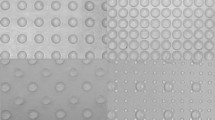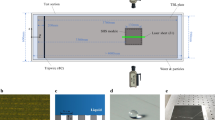Abstract
Measurements of turbulence with laser Doppler velocimetry (LDV) are compared for turbulent flows over a flat surface and a surface with sinusoidal waves of small wavelength. The wavy boundary was highly rough in that the flow separated. The Reynolds number based on the half-height of the channel and the bulk velocity was 46,000. The wavelength was 5 mm and the height to wavelength ratio was 0.1. The root-mean-squares of the velocity fluctuations are approximately equal if normalized with the friction velocity. This can be explained as a consequence of the approximate equality of the correlation coefficients of the Reynolds shear stress. Calculations with a direct numerical simulation (DNS) are used to show that the fluid interacts with the wall in quite different ways for flat and wavy surfaces. They show similarity in that large quadrant 2 events in the outer flow, for both cases, are associated with plumes that emerge from the wall region and extend over large distances. Measurements of skewness of the streamwise and wall-normal velocity fluctuations and quadrant analyses of the Reynolds shear stresses are qualitatively similar for flat and wavy surfaces. However, the skewness magnitudes and the ratio of the quadrant 2 to quadrant 4 contributions are larger for the wavy surface. Thus, there is evidence that turbulent structures are universal in the outer flow and for quantitative differences in the statistics that reflect differences in the way in which the fluid interacts with the wall.























Similar content being viewed by others
References
Andreopoulos J, Bradshaw P (1981) Measurements of turbulence structure in the boundary layer on a rough surface. Boundary-Layer Meteorol 20:201–213
Brooke JW, Hanratty TJ (1993) Origin of turbulence-producing eddies in a channel flow. Phys Fluids A 5:1011–1022
Cherukat P, Na Y, Hanratty TJ, Mclaughlin JB (1998) Direct numerical simulation of a fully developed turbulent flow over a wavy wall. Theoret Comput Fluid Dyn 11:109–134
Chong MS, Perry AE, Cantwell BJ (1990) A general classification of three-dimensional flow fields. Phys Fluids A 2:765–777
Cohen LS, Hanratty TJ (1968) Effect of waves at a gas–liquid interface on a turbulent gas flow. J Fluid Mech 31:467 – 479
Goodwin JW, Ottewill RH, Pelton R, Vianello G, Yateo DE (1978) Control of particle size in the formation of polymer lattices. Brit Polym J 10:173–180
Grass AJ (1971) Structural features of turbulent flow over smooth and rough boundaries. J Fluid Mech 50:233–255
Grass AJ, Stuart RJ, Mansour-Tehrani M (1993) Common vortical structure of turbulent flows over smooth and rough boundaries. AIAA J 31:837–847
Günther A, Papavassilious DV, Warholic MD, Hanratty TJ (1998) Turbulent flow in a channel at a low Reynolds number. Exp Fluids 25:503–511
Hanjalic K, Launder BE (1972) Fully developed asymmetric flow in a plane channel. J Fluid Mech 51:301–335
Hanratty TJ, Papavassiliou DV (1997) The role of wall vortices in producing turbulence. In: Panton RL (ed) Self-sustaining mechanisms of wall turbulence. Computational Mechanics Publications, Southampton, UK, pp 83–108
Heist DK, Hanratty TJ, Na Y (2000) Observations of the formation of streamwise vortices by rotation of arch vortices. Phys Fluids 12:2965–2975
Hudson JD, Dykhno L, Hanratty TJ (1996) Turbulence production in flow over a wavy wall. Exp Fluids 20:257–265
Juang MS, Krieger IM (1976) Emulsifier-free emulsion polymerization with ionie comonomer. J Polym Sci 14:2089–2107
Krogstad PA, Antonia RA, Browne LWB (1992) Comparison between rough and smooth wall turbulent boundary layers. J Fluid Mech 245:599–617
Krogstad PA, Antonia RA (1994) Structure of turbulent boundary layers on smooth and rough walls. J Fluid Mech 277:1–21
Krogstad PA, Antonia RA (1999) Surface roughness effects in turbulent boundary layers. Exp Fluids 27:450–460
Liu ZC, Adrian RJ, Hanratty TJ (2000) Large-scale modes of turbulent channel flow: transport and structure. TAM Report No.929, UILU-ENG-2000–6004, ISSN 0073 5264
Liu ZC, Landreth CC, Adrian RJ, Hanratty TJ (1991) High resolution measurement of turbulent structure in a channel with particle image velocimetry. Exp Fluids 10:301–312
Lu SS, Willmarth WW (1973) Measurements of the structure of the Reynolds stress in a turbulent boundary layer. J Fluid Mech 60:481–511
Mazouz A, Labraga L, Tournier C (1994) Behavior of the Reynolds stress on rough walls. Exp Fluids 17:39–44
Miya M (1966) Effect of waves on turbulence. PhD Thesis, University of Illinois, Urbana
Na Y, Hanratty TJ, Liu ZC (2001) The use of DNS to define stress producing events for turbulent flow over a smooth wall. Flow, Turb Combust 66:495–512
Niederschulte MA, Adrian RJ, Hanratty TJ (1990) Measurement of turbulent flow in a channel at low Reynolds numbers. Exp Fluids 9:222–231
Perry AE, Lim KL, Henbest SM (1987) An experimental study of the turbulence structure in smooth- and rough-wall boundary layers. J Fluid Mech 177:437–466
Pimenta MM; Moffat RJ; Kays WM (1979) The structure of a boundary layer on a rough wall with blowing and heat transfer. J Heat Transfer 101:193–198
Raupach MR (1981) Conditional statistics of Reynolds stress in rough-wall and smooth-wall turbulent boundary layers. J Fluid Mech 108:363–382
Raupach MR, Antonia RA, Rajagopalan S (1991) Rough-wall turbulent boundary layers. Appl Mech Rev 44:1–25
Schlichting H (1979) Boundary-layer theory, 7th edn. McGraw-Hill, New York
Shafi HS, Antonia RA (1997) Small-scale characteristics of a turbulent boundary layer over a rough wall. J Fluid Mech 342:263–293
Warholic MD (1997) Modification of turbulent channel flow by passive and additive devices. PhD thesis, University of Illinois, Urbana
Warholic MD, Schmidt GM, Hanratty TJ (1999) The influence of a drag-reducing surfactant on a turbulent velocity field. J Fluid Mech 388:1–20
Acknowledgement
This work was supported by the Natural Science Foundation under Grant NSF CTS 98-06265. We also acknowledge the support and facilities of the National Center for Supercomputing Applications at the University of Illinois in Urbana, Illinois.
Author information
Authors and Affiliations
Corresponding author
Rights and permissions
About this article
Cite this article
Nakagawa, S., Na, Y. & Hanratty, T.J. Influence of a wavy boundary on turbulence. . Exp Fluids 35, 422–436 (2003). https://doi.org/10.1007/s00348-003-0681-2
Received:
Accepted:
Published:
Issue Date:
DOI: https://doi.org/10.1007/s00348-003-0681-2




